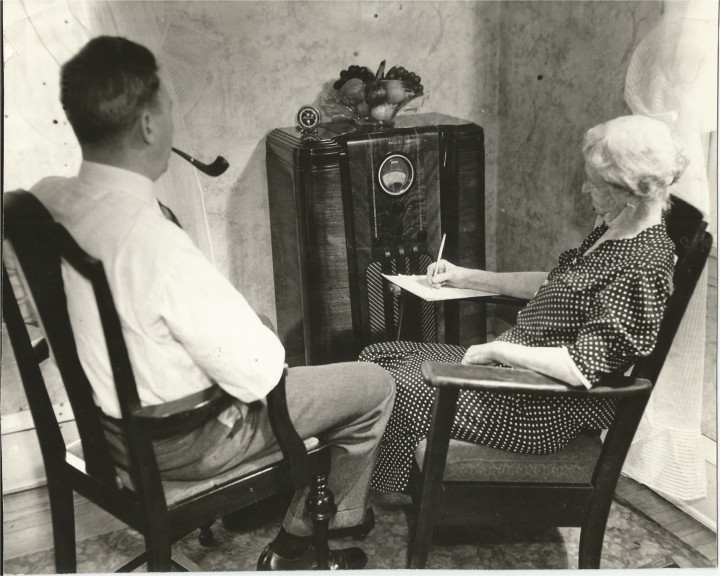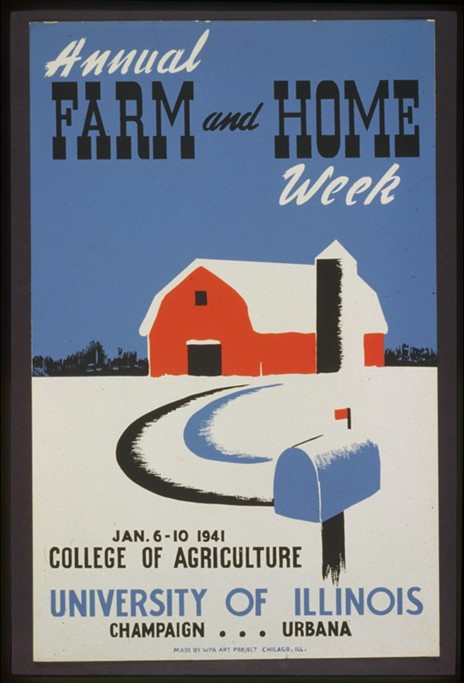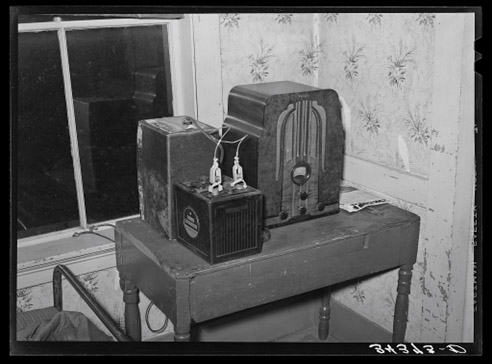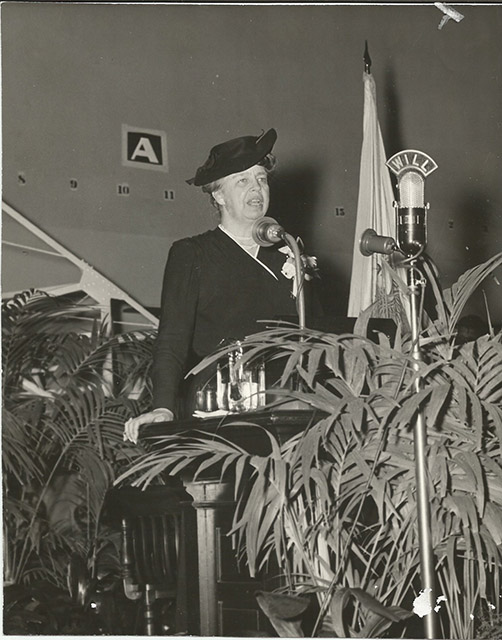Supporting area farmers from the beginning

Area farmers listening to WILL in the 1930s. The woman is likely jotting down the latest market prices.
WILL has been a vital resource for area farmers since the station’s inception. In fact, the first broadcast on April 6, 1922, featured a lecture titled “Turning Cream into Gold.” By 1928, specialists from the University of Illinois College of Agriculture were brought on to speak about land, crops, livestock, and other issues of concern to farmers. In March 1928, the Daily Illini reported that such talks would include “Feeding Your Chickens,” “Legumes and Prosperity,” “Machinery Developments for Corn Production,” and a home economics lecture by Fannie Brooks. By 1931, these informative agricultural pieces became a daily staple of WILL programming, even broadcasting special events such as the College of Agriculture’s annual research showcase, Farm and Home Week. In 1935, WILL began reporting daily market prices, and in 1947, WILL boasted it was the only station in the state with a full hour of farm programming and that it carried a more comprehensive market report than any other station.

Annual Farm and Home Week poster from 1941, Library of Congress control number: 92500875.
The radio played a key role in furthering the University of Illinois’ Extension service. Established in 1914 by the Smith–Lever Act, the Cooperative Extension service enabled the dissemination of information produced by the university’s agricultural experiment stations in partnership with the United States Department of Agriculture. These experimental stations were established through the Hatch Act of 1887 to help land-grant institutions research the agricultural issues facing the rural citizens these colleges were built to serve.
Though many rural Illinoisians did not yet have electricity or access to a radio receiver when WILL first came on air, the radio eventually proved an effective tool for disseminating this research. As the technology became more accessible, radio quickly appealed to rural Americans. Formerly isolated homes now had access to world news, up-to-date and detailed weather reports, entertainment, and agricultural programs. With this justification, many farmers bought battery-operated radio sets that could be charged at a local garage or by using a wind charger or a stationary gasoline engine belted to a generator.
In 1930, 27% of farmers had a radio set, while only 10% had electricity. Even though radio sets had become cheaper, it was still a major purchase for struggling farm families, and radio ownership among rural Americans would triple during the Great Depression. Many farmers saw its immense value not only for connecting them with the world but also for protecting their livelihoods. Weather forecasts and market reports guided farm decision-making, allowing farmers to save crops from early freezes or increase their profits through better timing of market deliveries. The radio proved so crucial that by 1940, more farmers owned radios (70%, or 84% outside the South) than had telephones, cars, or electricity. Even by the mid-1940s, only half of farm homes were on the power grid.

Example of a battery-operated farm radio. Photographer: Russell Lee, Oct. 1939. Library of Congress control number: 2017784438
When Hadley Read was brought on as the head of the Extension Editorial Office at the University of Illinois (later the Office of Agricultural Communications) in 1947, he recognized the vital role effective agricultural communication played in protecting and improving the livelihoods of Illinois farmers. In his 1959 book, Agricultural Communications Services, he wrote, “Communication is essential to agricultural development. It is the vital bridge that carries the results of research from the laboratory to the field. A steady flow of accurate, understandable, factual information links the scientist with the farmer.” He believed that agricultural communication, such as the programs offered on WILL, could speed the adoption of improved farm practices; help meet farming emergencies such as weather events, pests, and diseases; and increase understanding between farm and city people. The three resources that were necessary for rapid agricultural progress were capable scientists focused on solving the problems of farmers, farmers who trusted that science could help them, and a bridge of communication to carry knowledge from one source to another. For mid-twentieth-century farmers, the radio was the quickest and most comprehensive bridge.
“Food Will Win the War”
The radio also proved an essential tool in galvanizing the country during World War II, particularly in uniting urban and rural Americans in the war effort. Agricultural historian Steve Craig argued, “By the beginning of the 1940s, the groundwork had been laid for radio to provide the national communication link essential to bringing the country together to meet the challenges that lay ahead.”

Eleanor Roosevelt speaks at the University of Illinois’ Farm and Home Week in 1942.
On February 5, 1942, First Lady Eleanor Roosevelt came to the University of Illinois to speak at the College of Agriculture’s Farm and Home Week. She discussed the role of civilians in the defense of our nation by efficient and bountiful agricultural output from the floor of Huff Gymnasium. Though Roosevelt’s speech was not broadcast, Illinois Agricultural Extension Information staff member Candace Hurley had the privilege of conducting an exclusive five-minute interview with the first lady on WILL. In her speech, Roosevelt said, “We are in a world war—food is needed all over the world, not only on one front.” She continued, “War goods must be produced in a hurry. Rural communities must hurry with their production of food and become as self-sufficient as is possible . . . Each rural community must become mentally alert and realize the importance of planting the right food.”
The radio continued to be a tool for disseminating crucial information and engaging farmers in the war effort. In 1943, the Daily Illini reported that WILL and other Illinois stations were “cooperating in the use of timely material designed to be of interest and value to urban and rural families. Farmers and homemakers will find helpful suggestions for their war efforts in the many daily broadcasts.” Each day, there was a full roster of lectures from various departments of the College of Agriculture. These lectures encompassed every aspect of running a farm for maximum output and efficiency to support the war effort at home and abroad. For example, to promote wartime production of feed, representatives from the Department of Agronomy spoke on crop diseases and soil improvement, staff from the Illinois State Natural History Survey discussed how to control forage crop pests, the Department of Animal Husbandry and Animal Pathology and Hygiene gave a radio short course covering efficient feeding and control of livestock diseases, and the Department of Agricultural Engineering discussed accident and fire prevention and efficient operation of farm machinery.
In 1945, wartime gasoline and tire rations and restrictions on nonessential travel meant that most farmers could not attend the 44th Annual Farm and Home Week. Consequently, WILL decided to broadcast the entire four-day conference. Though WILL had broadcast certain speeches and events from the conference, it had never before broadcast the whole slate of activities. The Daily Illini reported, “Probably for the first time in radio history, practically an entire four-day conference will be put on the air . . . As many as 5,000 farmers have attended the sessions in the past. This year they will attend by radio from their easy chairs at home.”
Sound familiar? Just as Illinois Public Media has adjusted to meet public health measures during the COVID-19 pandemic, in 1945, WILL changed tacks to ensure area farms had access to the information they needed. Today, Illinois Public Media continues to be an invaluable source of agricultural information, with WILL Ag market reports and analysis available across multiple platforms.
Curious how WILL supported to women’s activities on the farm during this era? Check out our article on pioneering home economics broadcaster Jessie Heathman here.

